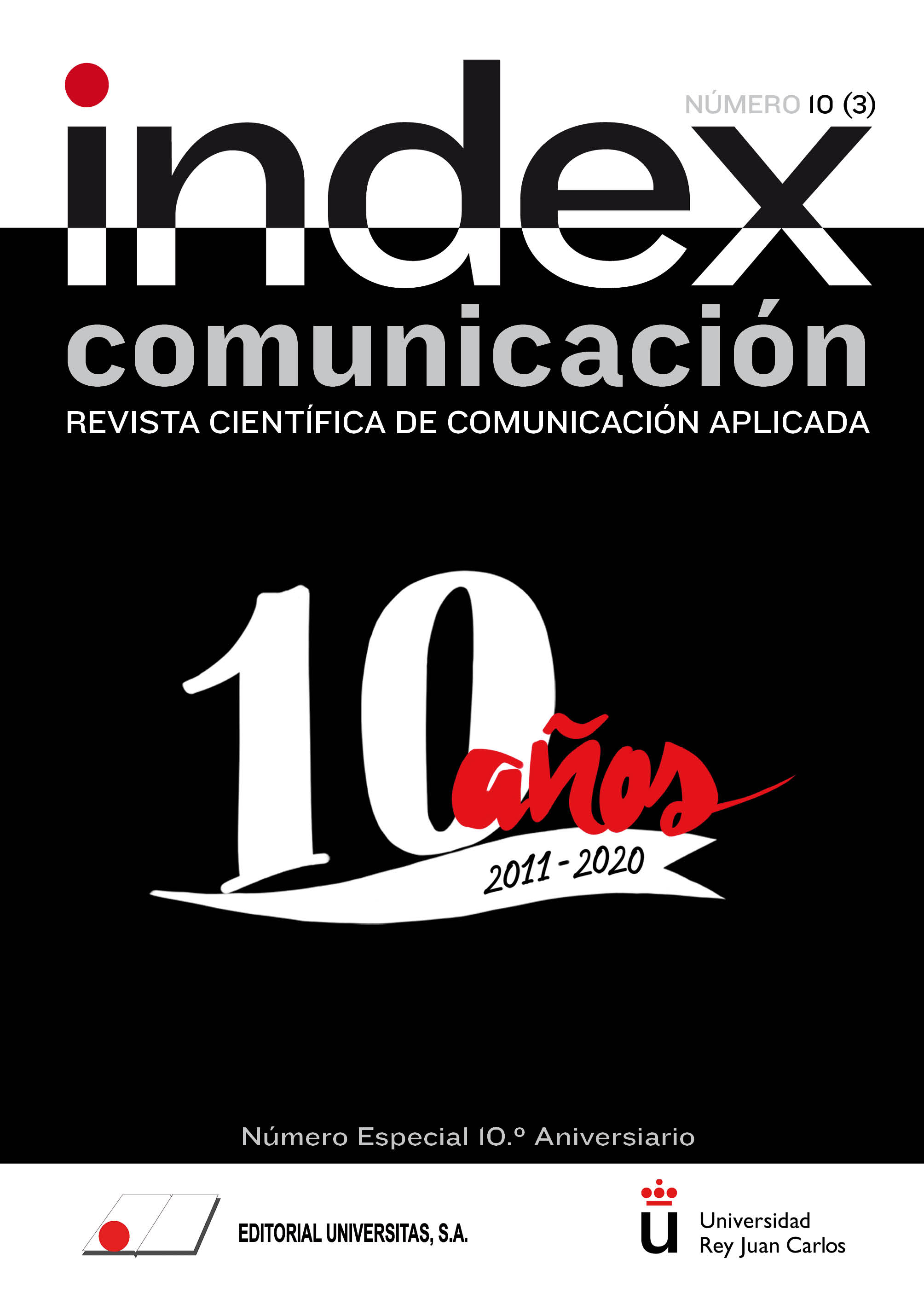Radio in the 21st Century Media Ecosystem: Case Study in Portugal
DOI:
https://doi.org/10.33732/ixc/10/03LaradiKeywords:
Radio, Internet, Media Ecosystem, New Media, Digital.Abstract
Since the appearance of television, the death of the radio has been expected. However, despite all the threats it is still alive and has seen an increase in audiences in a hostile scenario for a centennial media. Reality shows that the radio has transformed its weaknesses into strengths and has adapted to the new ecosystem faster than any other media. The reasons for this quick and successful adaptation are related to the simplicity of the support and to its unisensorial language, but also to an unprecedented capacity of adaptation to new situations. This work identifies the characteristics that makes radio a survivor and analyzes the way in which the radio adapted itself to the new ecosystem, illustrating each case with examples from Portuguese radios.
Metrics
References
AHONEN, T. (2011). Almanac 2011. Hong Kong: TomiAhonen Consulting
ANTENA 3 (2016). Não me obriguem a vir para a rua gritar. Disponible en https://www.rtp.pt/play/p2284/e400284/nao-me-obriguem-a-vir-para-a-rua-gritar
BARRIOS RUBIO, A. (2015). La radio colombiana frente al reto digital. Comunicación y Medios, 31, pp. 1-19.
doi.org/10.5354/0719-1529.2015.34367
BARRIOS RUBIO, A. & GUTIÉRREZ GARCÍA, M. (2016). Transición y adaptación de la industria radiofónica colombiana privada al entorno digital desde la perspectiva de los operadores. Revista ICONO14, 14 (2), pp. 231-255.
doi.org/10.7195/ri14.v14i2.959
BASTOS, H. (2000). Jornalismo Electrónico: Internet e Reconfiguração de práticas nas redações. Coimbra: Minerva.
BASTOS, H. (2000). Origens e evolução do Ciberjornalismo em Portugal: os primeiros vinte anos (1995-2015). Porto: Edições Afrontamento.
BOLTER, J. D. & GRUSIN, R. (1999). Remediation. Understanding New Media. Cambridge: The MIT Press.
BONIXE, L. (2015). Rádios locais em Portugal entre a proximidade e as regras do mercado. Jornalismo & Jornalistas, 61, pp.28-32.
CANAVILHAS, J. (2011). El nuevo ecosistema mediático. index.comunicación, 1(1), 13-24. Disponible en
https://journals.sfu.ca/indexcomunicacion/index.php/indexcomunicacion/article/view/4/16
CANAVILHAS, J. (2012). Da remediação à convergência: um olhar sobre os media portugueses. Brazilian Journalism Research, vol. 8, 1.
CEBRIÁN HERREROS, M. (2009). Expansión De La Ciberradio. Enl@ce: Revista Venezoelana de Información, Tecnología y Conocimiento, Vol. 6, 1, pp. 11-23.
CORDEIRO, P. & BONIXE, L. (2019). Pirata, Local, Global – que radio no século XXI? Jornalismo & Jornalistas, 68, pp.26-33.
EVANS, C. J. & SMETHERS, J. S. (2001). Streaming Into The Future. A Delphi Study of Broadcasters Attitudes Toward Cyber Radio Station. Journal of Radio Studies, 8: 1, pp. 5-28. doi.org/10.1207/s15506843jrs0801_4
FIDLER, R. (1997). Mediamorphosis: Understandig New Media.Thousand Oaks: Pine Forge Press.
HENDY, D. (2010). Listening in the dark: night-time radio and a “deep history” of media. In Media History, 16(2), pp.215-232.
doi.org/10.1080/13688801003656249
JEANNENEY, J-N. (1996). Uma História da Comunicação Social. Lisboa: Terramar.
LEI nº 87/88, de 30 de julho de 1988. Assembleia da República. Diário da República n.º 175/1988, Série I de 1988-07-30. Disponible en
LEI n.º 54/2010, de 24 de dezembro de 2010. Assembleia da República. Diário da República n.º 248/2010, Série I de 2010-12-24. Disponible en http://www.dre.pt
LEI n.º 78/2015, de 29 de julho de 2015. Assembleia da República. Diário da República n.º 146/2015, Série I de 2015-07-29. Disponible en http://www.dre.pt
LEVINSON, P. (1997). The Soft Edge: a natural history and future of the infor-mation Revolution. London: Routledge.
M80 (2016). Acha que sabe responder. Disponible en
https://m80.iol.pt/acha-que-sabe-responder/1
MCLUHAN, M. (1969). Os meios de comunicação como extensões do Homem. S. Paulo: Editora Cultrix.
MINIWATTS MARKETING GROUP (2020). Internet World Stats. Disponible en https://www.internetworldstats.com/stats.htm
OBCIBER (2019). Regulamento dos Prémios de Ciberjornalismo. Disponible en https://obciber.wordpress.com/premios/
PORTELA, P. (2015). A voz do utilizador na mediamorfose da rádio: a interatividade e os consumos radiofónicos do início do século XXI. Tesis de Doctorado. Universidade do Minho, Braga, Portugal. Disponible en http://hdl.handle.net/1822/35828
PRIESTMAN, C. (2002). Web radio: radio production for Internet streaming, Oxford: Focal Press.
RÁDIO COMERCIAL (2006). O meu blogue dava um programa de rádio. No disponible online.
RÁDIO COMERCIAL (2019). Ora deixa cá ver. Disponible en
https://podcasts.apple.com/pt/podcast/r%C3%A1dio-comercial-ora-deixa-c%C3%A1-ver/id1458334091
RÁDIO RENASCENÇA (2019). RR/V+. Disponible en https://rr.sapo.pt/vmais
ROST, A. (2014). Interatividade: Definições, estudos e tendências. In J. Canavilhas (Ed.), Webjornalismo: 7 caraterísticas que marcam a diferença, pp.53-88. Covilhã: Livros Labcom. Disponible en
http://www.labcom-ifp.ubi.pt/ficheiros/20141204-201404_webjornalismo_jcanavilhas.pdf
ROSEN, J. (2008). The people formerly known as the audience. In N. Carpentier, & B. DeCleen (Eds.), Participation and Media Production: Critical Reflec-tions on Content Creation. Cambridge Scientific Publishers Ltd.
SANTOS, R. (2005). Rádio em Portugal: tendências e grupos de comunicação na actualidade. Comunicação e Sociedade, vol. 7, pp.137-152.
SILVA, N. M. (2012). Radio and the Web: BBC Radio as a new model of radio communication. In Madalena Oliveira; Pedro Portela; Luís António Santos (Eds), Radio evolution: Conference Proceedings, pp.413-420. Disponible en http://www.lasics.uminho.pt/ojs/index.php/radioevolution/article/download/836/812
YIN, R. K. (1994). Pesquisa Estudo de Caso - Desenho e Métodos. Porto Alegre: Bookman.
Published
How to Cite
Issue
Section
License
Copyright (c) 2020 João Canavilhas

This work is licensed under a Creative Commons Attribution-NonCommercial 4.0 International License.
Authors who submit to this journal agree to the following terms:
Authors retain copyright and ensure the magazine's right to be the first publication of the work as licensed under a Creative Commons Attribution-NoComercial 4.0 International License that allows others to share the work with an acknowledgment of authorship of the work and the initial publication in this magazine, with no commercial purpose.
Authors can establish separate additional agreements for non-exclusive distribution of the version of the work published in the magazine (for example, to an institutional repository or publish it in a book), with an acknowledgment of its initial publication in this journal.
It allows and authors are encouraged to disseminate their work electronically (eg, in institutional repositories or on their own website) prior to and during the submission process, as it can lead to productive exchanges, as well as a citation more early and most of the published work (See The Effect of Open Access).















